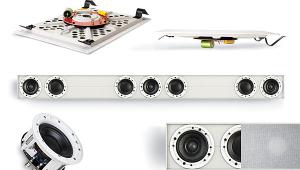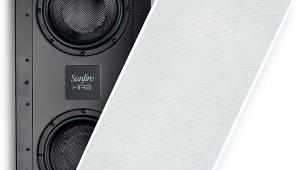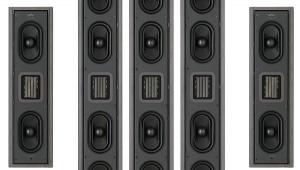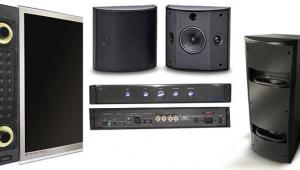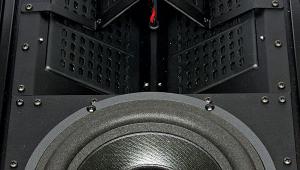Wow just nice and it is amazing thanks for sharing this http://vturesultsinfo.webs.com/
Origin Acoustics Director D108 In-Ceiling Speaker Review
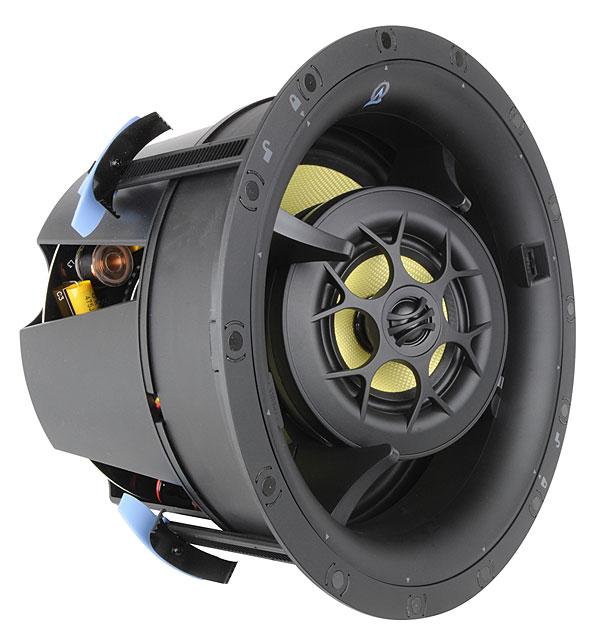
AT A GLANCE
Plus
Tool-free twist-lock mounting
10-inch woofer fits an 8-inch cutout
Aimable tweeter and midrange
Minus
Requires 7.5 inches of mounting depth
Wants lots of power
Raised soundstage
THE VERDICT
No in-ceiling architectural speaker is perfect, but the D108 comes stunningly, spectacularly close.
Love him, hate him, or simply wonder what’s up with all the tattoos, there’s no denying the fact that Jeremy Burkhardt is one of those distinct personalities who has had a profound effect on the custom audio/video industry. Then again, he may be someone you’ve never heard of, unless you’re in the custom installation business. Unlike other notables—such as Polk, Carver, and Bose—Burkhardt isn’t the name of a speaker brand. Nevertheless, if you’ve listened to a set of in-wall or in-ceiling speakers, especially one of the bazillion or more models SpeakerCraft has produced over the past 25 years (including tons built for other brands), you’ve felt—or, rather, heard—Burkhardt’s influence on architectural audio.
As they say, however, what have you done for me lately, Mr. Burkhardt? The answer: Origin Acoustics. Bored with retirement, Burkhardt (along with two fellow originators of SpeakerCraft, Ken Humphreys and Ed Haase—thus the “Origin” in the new company’s name) decided to “invent and create the world’s best-sounding loudspeakers.” Of course, no one starts out with the idea of making
“the world’s third or fourth best” or “fair-to-middling” speakers. But these guys claim an impressive 100-plus years of design and engineering experience among them, so they have about as good a shot as anybody at hitting the target.

If You’ve Got a Hole…
You could say that the dictum at Origin Acoustics is, “If you’ve got a hole, we’ve got a speaker to fill it.” (Or…maybe not.) In any case, the two-year-old company already offers 40 different models, with more to be released soon. The current lineup includes traditional in-wall and in-ceiling configurations, thin-fit designs, all-weather cabinet models, “landscape” speakers, and in-ground outdoor subwoofers. There’s a trio of in-room subs, and Burkhardt told me there’ll be an appropriate assortment of architectural subs in just a couple of months.
The Director D108 is Origin’s top-of-the-line in-ceiling speaker, and the company shipped several of them for this review. However, true to Burkhardt’s philosophy of “go big, or go bigger,” he didn’t send a typical five-channel system (such as a trio of D108s plus a couple of smaller in-ceiling speakers for the surrounds). Instead, UPS brought nine D108s—along with the polite suggestion from Burkhardt that I try out an all-in-ceiling Dolby Atmos 5.0.4 system. (More an that “0” later.)
At this point, depending on your familiarity with Atmos, you’re either bemused or totally confused. I’ll skip over the technical stuff and begin by saying that Atmos for your home theater is a setup that can reproduce movie sound in three dimensions: side to side, front to back, and floor to ceiling. Atmos playback, in its recommended configuration, requires four height-channel speakers (two if you’re a cheapskate) in addition to the five or more speakers in a normal surround system. For ideal situations, Dolby recommends using in-ceiling speakers for the height channels and in-room speakers for the rest. An alternative is the use of Atmosenabled in-room speakers that reflect sound for the height channels off the ceiling.

Conspicuously absent is a recommended configuration with all in-ceiling speakers (with or without a sub). It may seem logical to avoid that setup, since it’s difficult to create a separate sense of height when all the speakers are aligned in the same plane (i.e., the ceiling). But that doesn’t necessarily mean an all-in-ceiling configuration won’t work. In fact, Burkhardt isn’t the first speaker peddler with whom I’ve discussed the idea. And according to Burkhardt, a few Origin Acoustics dealers have been selling and installing in-ceiling Atmos systems and getting great results.
So, despite the prospect of me laboriously cutting nine large holes in my theater room’s ceiling, S&V editor Rob Sabin gave me the architectural-Atmos go-ahead, with the caveat that any structural damage, bodily injury, or grief (from Dolby or my family) was totally my responsibility. Empathy is not his strong point. [Ed. Note: At this point, Darryl has cut so many holes in his listening room ceiling and walls that his house is in danger of falling down. We can’t let him review anything else without signing a release form.—RS]
Depth and Axes
One of the D108’s bigger (or smaller, depending on your outlook) selling points has to do with size. The woofer, for example, is 10 inches in diameter, which results in approximately 60 percent more surface area than what the more commonly used 8-inch woofer provides. In-ceiling speakers with 10-inch woofers are rare, primarily because that diameter and the associated weight usually require a big, gaping hole to be cut into the ceiling, with an even larger bracket to hold it in place and an impossible-to-hide, industrial-looking grille/flange to cover it. After all, in-ceiling speakers are supposed to disappear in the ceiling—not replace the ceiling.
As it is, the required cutout for most in-ceiling speakers with 8-inch woofers ranges from 9.4 to almost 11 inches in diameter, and the few speakers with 10-inch woofers need well over 12 inches. Surprisingly, the D108 requires only a 103/8-inch hole. Think about that. The hole the D108 fits into is only 3/8 of an inch larger than the woofer itself. Increasing the size of the woofer comes at a cost, however, and that cost is added depth. Whereas in-ceiling speakers with 8-inch woofers rarely extend beyond 6 inches, the D108 is 7.5 inches deep, which means you’ll need plenty of open cavity above the ceiling where the speakers are going to be mounted.
Another reason for the extra depth is the fact that the woofer is recessed approximately 3 inches behind the grille, making room for the hemispherical tweeter/midrange assembly that “floats” above the woofer on four side-support struts that allow it to pivot up to ±18 degrees off axis. The 0.75-inch tweeter suspended above the 4-inch midrange pivots independently, too. Both the woofer and midrange cones are made using Kevlar as an ingredient. (I assume that means they’re at least somewhat bulletproof, but I decided not to test that since I had enough holes in my ceiling already.) [Ed. Note: As I was saying…—RS]
Zippity-Clippity-Doo-Dah
Whether you’re a homeowner hiring professional installers or a dyedin-the-wool do-it-yourselfer, ease of installation is very important— especially when it comes to in-ceiling speakers—because it can help keep labor costs and/or DIY time to a minimum. Thankfully (since I used nine speakers), the only way the D108 could be easier to install is if it cut the hole itself. Of course, installation isn’t totally tool-free, as you’ll need some sort of device to cut the required 105/8-inch hole in the ceiling. (In addition to the basic drywall knife, there’s a variety of hole-cutters out there. Parts Express has an awesome adjustable one that cuts holes up to 11.75 inches in diameter and includes a clear dust shroud that makes the need for cleaning up almost nonexistent.)
Once the hole is cut, you insert the slightly flexible mounting bracket into it and squeeze the four ratcheting “ZipClips” to compress the ceiling tile or drywall between them and the outer flange of the mount. The end result is similar to using traditional dog-ear clamps—except that no screwdriver is required. After connecting the speaker wire to the D108’s spring-loaded terminals, you slide the speaker into the bracket, line up one of the tiny triangles printed around the outer edge of the speaker with the “unlocked” symbol on the flange, and then turn the speaker about 11/8 inches clockwise until it locks into place. Located opposite one another on the outer rim of the speaker chassis are three-position switches for bass and treble adjustments. The magnetic grille is so excited to be part of the system that it leaps from your hand to the front of the speaker.
While we’re on the topic of installation, all of Origin Acoustics’ Director Collection speakers, including the D108, have a certified weatherproof rating of IPX6. Origin says the rating “ensures that these highperformance speakers are safe from the corrosion and internal damage posed by ocean water and rainstorms” as well as sprinkler systems and garden hoses. That means they can be installed in bathrooms and saunas, outside under eaves, and even on boats. Submarines are out, though, because the D108s are not rated for total immersion.
Ceilings Don’t Have Ears
In-ceiling speakers don’t get much respect, for good reason. Most of them sound awful, and worse, many are cheap pieces of crap made from little more than twisted animal balloons (used), toilet paper (new), and soda cans (empty but still a little sticky). The end result is something that barely deserves to be used for background music (so-called). Quality of parts and engineering notwithstanding, there’s also the hard-to-overcome issue of the speaker being placed above your ears instead of in front of them.
- Log in or register to post comments





